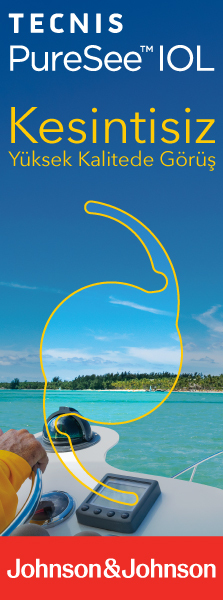TJ-CEO
2009 , Vol 4 , Num 2
Evaluation of Corneal Biomechanical Properties Measured By Ocular Response Analyzer in Pseudophakic Patients
1Sağlık Bakanlığı Ulucanlar Göz Hastanesi, Ankara, Prof. Dr.2Kocatepe Üniversitesi Tıp Fakültesi, Göz Hastalıkları A.D., Afyon, Yrd. Doç. Dr.
3Kocatepe Üniversitesi Tıp Fakültesi, Göz Hastalıkları A.D., Afyon, Doç. Dr. Purpose: To assess the corneal biomechanical properties by ocular response analyzer in pseudophakic patients and compare them with those in healthy subjects.
Materials and Methods: Forty eyes of 40 patients who underwent uneventful phacoemulsification cataract surgery were included in the study. Group 1 (n=40) consisted of pseudophakic eyes, group 2 (n=40) consisted of nonoperated fellow eyes of the same patients, and group 3 (n=40) consisted of eyes of age-matched healthy subjects. Corneal-compensated intraocular pressure (IOPcc), Goldmann-correlated IOP (IOPg), corneal hysteresis (CH), and corneal resistance factor (CRF) were measured by ocular response analyzer (ORA) at the postoperative 2nd month. Intraocular pressure with Goldmann applanation tonometer (GAT IOP) and central corneal thickness (CCT) with ultrasonic pachymeter were also measured. Statistical analyses were performed using ANOVA, Student’s t-test, and Pearson’s correlation analysis.
Results: All measurements were performed at postoperative 8.6±2.8 weeks in pseudophakic patients. Mean IOPcc was 17.1±3.9 mmHg, IOPg was 16.4±4.5 mmHg, CRF was 10.4±2.4 mmHg, CH was 10.07±1.9 mmHg, and CCT was 558 μm in pseudophakic patients (p=0.252, 0.663, 0.219, 0.92, 0.121, respectively). IOPcc-GAT IOP mean difference was 2.1 mmHg (p=0.006) and IOPg-GAT IOP mean difference was 1.4 mmHg (p=0.09) in pseudophakic patients. IOPg, CH, and CRF showed significant correlations with CCT (r=0.437, p=0.005; r=0.568, p=0.001; r=0.632, p=0.001, respectively) but there were no correlation between CCT and IOPg (r=0.144, p=0.375), or between CCT and GAT IOP (r=0.154, p=0.343) in pseudophakic patients.
Conclusion: Corneal biomechanical parameters measured by ORA do not change significantly in pseudophakic patients and cataract surgery seems not to affect the viscoelastic properties of the cornea at the 2nd postoperative month. Keywords : Ocular response analyzer, goldmann applanation tonometer, central corneal thickness, pseudophakia





